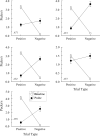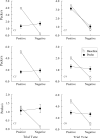Transitive and anti-transitive emergent relations in pigeons: support for a theory of stimulus-class formation
- PMID: 25050907
- PMCID: PMC4298484
- DOI: 10.1016/j.beproc.2014.07.006
Transitive and anti-transitive emergent relations in pigeons: support for a theory of stimulus-class formation
Abstract
Stimulus class formation is inferred when conditional discrimination training yields new (emergent) conditional relations between the training stimuli. The present experiments demonstrated two such relations in pigeons after successive matching-to-sample training. Experiment 1 showed that transitivity (AC matching) emerged after training on AB and BC arbitrary matching plus BB identity matching: pigeons responded relatively more to the comparisons on AC test trials in which both the A samples and C comparisons were elements of reinforced arbitrary baseline relations involving the same nominal B stimulus. Experiment 2 showed the opposite effect ("anti-transitivity") after training on the same arbitrary relations but with BB oddity instead: pigeons responded relatively more to the comparisons on AC test trials in which the A sample was an element of a reinforced baseline relation and the C comparison was an element of a non-reinforced baseline relation, or vice versa. Experiment 2 also showed that AB and BC training alone generally does not yield an emergent effect. These findings extend the range of emergent phenomena observed in non-human animals and are consistent with predictions from Urcuioli's (2008) theory of pigeons' stimulus class formation. This article is part of a Special Issue entitled: Tribute to Tom Zentall.
Keywords: Anti-transitivity; Emergent relations; Pigeons; Stimulus classes; Successive matching; Transitivity.
Copyright © 2014 Elsevier B.V. All rights reserved.
Figures









Similar articles
-
A replication and extension of the antisymmetry effect in pigeons.J Exp Anal Behav. 2012 Nov;98(3):283-93. doi: 10.1901/jeab.2012.98-283. J Exp Anal Behav. 2012. PMID: 23144506 Free PMC article.
-
Concurrent identity training is not necessary for associative symmetry in successive matching.J Exp Anal Behav. 2014 Jan;101(1):10-25. doi: 10.1002/jeab.51. Epub 2013 Sep 30. J Exp Anal Behav. 2014. PMID: 24436073 Free PMC article.
-
Reflexivity without identity matching training: A first demonstration.J Exp Anal Behav. 2018 Jan;109(1):125-147. doi: 10.1002/jeab.302. Epub 2018 Jan 10. J Exp Anal Behav. 2018. PMID: 29318632
-
An update on the search for symmetry in nonhumans.J Exp Anal Behav. 2021 Jan;115(1):309-325. doi: 10.1002/jeab.647. Epub 2020 Nov 22. J Exp Anal Behav. 2021. PMID: 33225440 Review.
-
The search for symmetry: 25 years in review.Learn Behav. 2009 May;37(2):188-203. doi: 10.3758/LB.37.2.188. Learn Behav. 2009. PMID: 19380896 Free PMC article. Review.
Cited by
-
A successful search for symmetry (and other derived relations) in the conditional discriminations of pigeons.Conductual. 2015 Apr;3(1):4-25. Conductual. 2015. PMID: 28386579 Free PMC article.
-
Abstraction, Multiple Exemplar Training and the Search for Derived Stimulus Relations in Animals.Perspect Behav Sci. 2017 Nov 1;41(1):45-67. doi: 10.1007/s40614-017-0112-y. eCollection 2018 Jun. Perspect Behav Sci. 2017. PMID: 32004363 Free PMC article.
-
Emergent identity but not symmetry following successive olfactory discrimination training in rats.J Exp Anal Behav. 2015 Sep;104(2):133-45. doi: 10.1002/jeab.169. J Exp Anal Behav. 2015. PMID: 26377436 Free PMC article.
-
A Neurocomputational Approach to Trained and Transitive Relations in Equivalence Classes.Front Psychol. 2017 Oct 18;8:1848. doi: 10.3389/fpsyg.2017.01848. eCollection 2017. Front Psychol. 2017. PMID: 29093696 Free PMC article.
References
-
- Bovet D, Vauclair J. Functional categorization of objects and of their pictures in baboons (Papio anubis). Learning and Motivation. 1998;29:309–322.
-
- Cullinan VA, Barnes D, Smeets PM. A precursor to the relational evaluation procedure: Analyzing stimulus equivalence. The Psychological Record. 1998;48:121–145.
Publication types
MeSH terms
Grants and funding
LinkOut - more resources
Full Text Sources
Other Literature Sources

